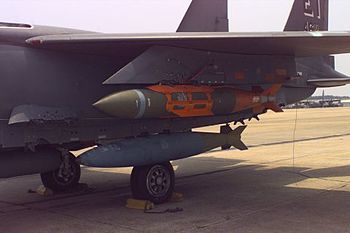| BLU-109 | |
|---|---|
 A BLU-109 aboard an F-15E Strike Eagle configured as a JDAM | |
| Type | Free-fall penetration bomb (guided when equipped as JDAM or Paveway) |
| Place of origin | United States |
| Service history | |
| In service | 1985-present |
| Used by | United States Air Force Israeli Air Force |
| Wars | |
| Specifications | |
| Mass | 2,000 lb (910 kg) |
| Length | 7 ft 11 in (2.41 m) |
| Diameter | 14.6 in (370 mm) |
| Filling | Tritonal [1] |
| Filling weight | 550 lb (250 kg) [1] |


The BLU-109/B is a hardened bunker buster penetration bomb used by the United States Air Force (BLU is an acronym for Bomb Live Unit). As with other "bunker busters", it is intended to penetrate concrete shelters and other hardened structures before exploding. In addition to the US, it is part of the armament of the air forces of Australia, Belgium, Canada, Denmark, France, Germany, Greece, Italy, Israel, Netherlands, Norway, Pakistan, Saudi Arabia, United Kingdom, and United Arab Emirates. [2]